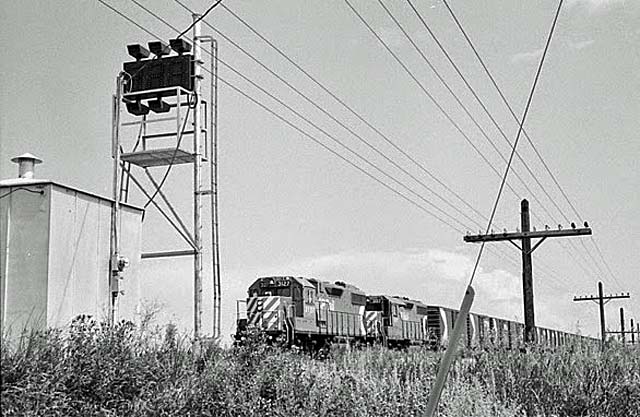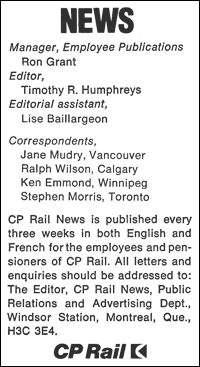|
|
Volume 13
Number 2 January 26, 1983 |

|
Detectors Installed

Montreal - CP Rail installed an additional 58 hot box detectors during the 1982 construction season just ended, bringing to 167 the number of the devices the railway now has in service.
"The 1982 installations are part of a $25 million hot box detector program by the railway," said John Kelsall, vice-president operation and maintenance CP Rail. "They improve the safety of train operations and help protect population centres near the railway line.
"During the past two years alone we have installed 89 detectors, more than half the total, at a cost of $11 million to augment protection already provided centres of population while meeting Canadian Transport Commission (CTC) requirements," he said.
The CTC ruled in 1981 that hot box detectors must be installed or manual inspections made at railway gateways to Canadian population centres of 100,000 or more by 1 Oct 1982, centres of 50,000 or more by 1 Oct 1984, and centres of 10,000 or more by 1 Oct 1987. The railway estimates the total cost of the program will be around $25 million.
The hot boxes are caused by wheel bearing failure which produces heat and can weaken the steel at the end of the freight car axle, causing it to break under the weight of the car. Bearing failure results from lubrication breakdown which can be caused by an imbalanced load or damaged axle.
TWO METHODS USED
The railway's hot box detector installations include devices to alert train crews to dragging equipment and sticking brakes. Trackside heat sensors detect sticking brakes and hot boxes, while a simple vertical bar, set in the center of the track and extending just above the height of the rails, sets off a signal when struck by a dragging or displaced object.
 Two methods are used to transmit
data from the detectors. The remote system produces a printout to alert a railway dispatcher or operator who then advises the train crew by radio. The
second method employs a large, trackside screen which automatically displays the data for train crews travelling in either direction. Both methods
indicate the precise location of the hot box, sticking brake, or dragging equipment.
Two methods are used to transmit
data from the detectors. The remote system produces a printout to alert a railway dispatcher or operator who then advises the train crew by radio. The
second method employs a large, trackside screen which automatically displays the data for train crews travelling in either direction. Both methods
indicate the precise location of the hot box, sticking brake, or dragging equipment.
Hot boxes occur mainly in plain bearing wheel assemblies which require manual inspection and lubrication. Roller bearing assemblies are sealed and overheat less frequently. Since 1967, all rolling stock purchased by CP Rail has been equipped with roller bearings. The railway has also converted more than 7,500 cars since 1974 from plain to roller bearing at a cost of almost $31 million.
The 1983 installation program will provide protection earlier than required by the CTC for some population centres of less than 50,000. This year, the railway plans to install seven detectors in British Columbia, eight in Alberta, three in Saskatchewan, two in Manitoba, 13 in Ontario, eight in Quebec, and one in New Brunswick at a cost of approximately $5,250,000.
Of the 89 hot box detectors installed in 1981 and 1982, 14 are in British Columbia, 11 in Alberta, 18 in Saskatchewan, nine in Manitoba, 26 in Ontario, 10 in Quebec, and one in New Brunswick.

